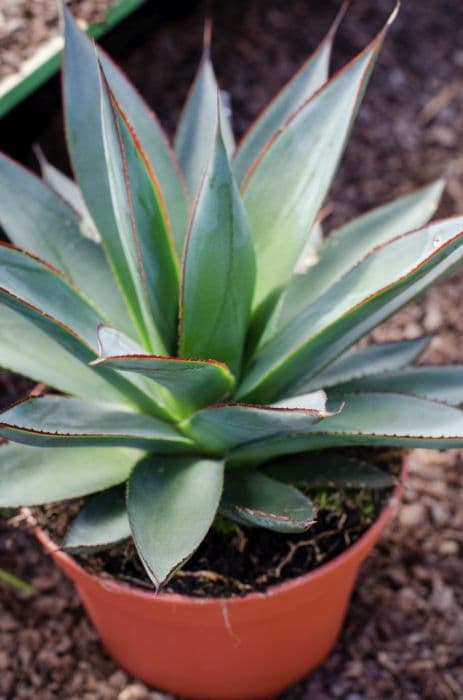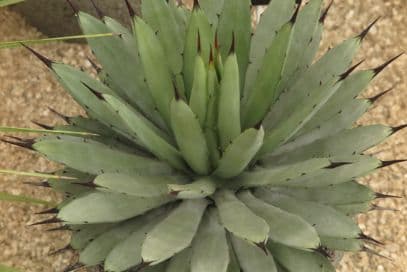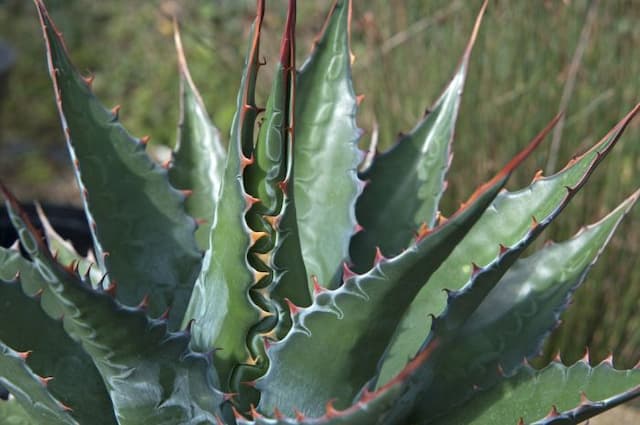Striped Solomon's Seal Polygonatum × hybridum 'Striatum' (v)

ABOUT
Polygonatum × hybridum 'Striatum', commonly known as variegated Solomon's seal, is a perennial plant known for its graceful, arching stems and striking foliage. The leaves of variegated Solomon's seal are oval to lance-shaped with pointed tips, and they have creamy-white edges that beautifully contrast the green center. The variegation adds a light, airy texture to the garden. In spring, small, bell-shaped flowers, which are white with green tips, hang in pairs or sometimes alone from the leaf axils beneath the arching stems. As the season progresses, these blossoms may develop into small, blue-black berries that provide additional visual interest. The gentle arching nature of the stems and the variegated leaves create a soft, elegant appearance. The details of the plant's foliage, combined with the delicate hanging flowers, give it a sophisticated charm that's sought after in shaded garden designs or woodland settings.
About this plant
 Names
NamesFamily
Asparagaceae.
Synonyms
Variegated Solomon's Seal, Striped Solomon's Seal.
Common names
Polygonatum × hybridum 'Striatum' (v).
 Toxicity
ToxicityTo humans
Polygonatum × hybridum 'Striatum' is commonly known as Variegated Solomon's Seal. This plant is not typically considered poisonous to humans, and there are no well-documented cases of toxicity from ingesting parts of this plant. However, as with any plant material, it may cause irritation or an allergic reaction in some individuals if ingested. Therefore, it is generally recommended to avoid eating any part of ornamental plants like the Variegated Solomon's Seal.
To pets
Variegated Solomon's Seal is not known to be highly toxic to pets. However, it is always best to prevent pets from ingesting plants as they may cause gastrointestinal upset, such as vomiting or diarrhea, due to the plant material's irritation to the stomach. There is no documented severe toxicity from pets ingesting Variegated Solomon's Seal, but it is advisable to keep an eye on your pet and consult a veterinarian if you suspect your pet has ingested any part of the plant.
 Characteristics
CharacteristicsLife cycle
Perennials
Foliage type
Deciduous
Color of leaves
Green
Flower color
White
Height
2-3 feet (60-90 cm)
Spread
1-2 feet (30-60 cm)
Plant type
Herb
Hardiness zones
3-8
Native area
Europe
Benefits
 General Benefits
General Benefits- Aesthetic Appeal: Polygonatum × hybridum 'Striatum', commonly known as Variegated Solomon's Seal, adds visual interest to gardens with its arching stems and variegated leaves.
- Shade Tolerance: Variegated Solomon's Seal thrives in shady areas, making it an excellent choice for woodland gardens or shaded borders.
- Drought Resistance: Once established, Variegated Solomon's Seal can tolerate periods of drought, reducing the need for frequent watering.
- Seasonal Interest: This plant provides spring flowers, variegated foliage throughout the summer, and can have yellow fall foliage, offering multiple seasons of interest.
- Wildlife Attraction: The flowers of Variegated Solomon's Seal attract pollinators like bees, while the berries can attract birds.
- Low Maintenance: Variegated Solomon's Seal is relatively low maintenance, requiring minimal pruning or care once it is established in the garden.
- Spread Control: Although the plant can spread by rhizomes, its growth is slow to moderate, which means it's less likely to become invasive and is easier to manage.
 Medical Properties
Medical PropertiesThis plant is not used for medical purposes.
 Air-purifying Qualities
Air-purifying QualitiesThis plant is not specifically known for air purifying qualities.
 Other Uses
Other Uses- Polygonatum × hybridum 'Striatum', commonly known as the striped Solomon's seal, can be used as a flour alternative when dried and ground from its rhizomes after they have been thoroughly cooked.
- The tender young shoots of Solomon's seal are edible when cooked, and they can be prepared similar to asparagus.
- As a natural dye, the foliage of the striped Solomon's seal can be used to produce subtle green shades on textiles.
- The plant's crushed leaves can be applied to the skin as a poultice to help soothe minor bruises or superficial inflammations.
- Solomon's seal can be incorporated into a garden as a structural plant to create borders or define edges along pathways.
- The plant can serve a symbolic role in gardens designed with a biblical or religious theme due to its name's historical and cultural references.
- In flower arranging, Solomon's seal's arching stems and delicate white flowers provide a graceful and elegant addition to bouquets and floral displays.
- The dried seed pods add a unique textural element to dried flower arrangements or wreaths for long-lasting decoration.
- Photographers and artists may use the plant as a subject, capturing its interesting striped stems and bell-shaped flowers for studies in form and color contrast.
- In shaded woodland gardens, Solomon's seal can be utilized as a companion plant to ferns, providing a diverse understorey landscape.
Interesting Facts
 Feng Shui
Feng ShuiThe Solomon's Seal is not used in Feng Shui practice.
 Zodiac Sign Compitability
Zodiac Sign CompitabilityThe Solomon's Seal is not used in astrology practice.
 Plant Symbolism
Plant Symbolism- Longevity: The plant's scientific name, Polygonatum, comes from the Greek for 'many knees', referring to the many-jointed rhizome from which the long-lived plants sprout, symbolizing a long and healthy life.
- Healing: Traditional use in herbal medicine ascribed healing properties to the plant, particularly in relation to skin conditions and inflammation, making it a symbol of healing and medicinal care.
- Growth and Versatility: The 'Striatum' variety is known for its variegated leaves, which can signify diversity and adaptability in growth, both in gardens and in personal development.
- Grace and Elegance: With its arching stems and delicately hanging flowers, Solomon's Seal is often associated with gracefulness and architectural elegance in the garden.
- Protection: In folk traditions, the roots and seals of the plant were sometimes used in protective amulets, representing safety and warding off negativity or evil.
 Water
WaterSolomon's Seal prefers consistently moist soil, particularly during the spring and early summer when the plant is actively growing. Water the plant deeply once a week, providing about 1 to 1.5 gallons of water per session, depending on the soil type and weather conditions. During hot, dry periods you may need to water twice a week, ensuring the soil doesn't dry out completely. Cut back on watering in the fall as the plant begins to die back and requires less moisture.
 Light
LightSolomon's Seal thrives best in partial to full shade, so an ideal spot would be under a canopy of deciduous trees where it receives dappled sunlight. Avoid placing it in full, direct sunlight as this can scorch the leaves and lead to stress on the plant. The gentle morning sun with afternoon shade or filtered light throughout the day is perfect for this variegated variety.
 Temperature
TemperatureSolomon's Seal is hardy and can survive in a temperature range from 5 to 85 degrees Fahrenheit. It prefers cooler conditions and is ideal in climates where temperatures consistently range between 60 and 70 degrees Fahrenheit during the growing season. Avoid locations where winter temperatures drop below 5 degrees Fahrenheit without adequate snow cover or mulch to protect the roots.
 Pruning
PruningSolomon's Seal requires minimal pruning. Cutting back the stems to ground level after they have yellowed in the fall will help to maintain a tidy appearance and can prevent potential disease issues. Occasional removal of dead or damaged foliage during the growing season is also beneficial. The best time for a major cutback is late fall or early winter after the plant has gone dormant.
 Cleaning
CleaningAs needed
 Soil
SoilSolomon's Seal prefers a rich, well-draining soil mix with a pH of around 5.5 to 7. A mix of garden soil, compost, and leaf mold or peat moss is ideal for maintaining the necessary fertility and moisture retention.
 Repotting
RepottingSolomon's Seal does not need frequent repotting and can be done every 3-4 years. They prefer to be slightly root-bound, so repotting too often can hinder their growth.
 Humidity & Misting
Humidity & MistingSolomon's Seal thrives in moderate to high humidity levels but is quite adaptable. They perform well in typical garden humidity conditions without the need for additional humidity control.
 Suitable locations
Suitable locationsIndoor
Place in filtered light, keep soil moist, and provide good air flow.
Outdoor
Plant in partial shade, ensure moist, fertile soil.
Hardiness zone
3-8 USDA
 Life cycle
Life cyclePolygonatum × hybridum 'Striatum', commonly known as the Striped Solomon's Seal, begins its life as a perennial rhizome underground, which sprouts anew each spring. Initially, shoots emerge from the rhizomes and develop into arching stems with alternating, striped leaves. As the plant matures, small, bell-shaped white flowers with green tips appear in late spring, hanging from the leaf axils underneath the arching stems. Following pollination, typically by insects, the flowers develop into blue-black berries by late summer, which contain seeds capable of producing new plants. During autumn, the plant's foliage turns yellow and fades as the aboveground portion dies back, retreating to the rhizome for dormancy throughout the winter. The cycle repeats the following spring when the plant reemerges from dormancy to grow and reproduce again.
 Propogation
PropogationPropogation time
Spring to Summer
The most popular method of propagating Solomon's seal (Polygonatum × hybridum 'Striatum') is by division. This process typically takes place in late fall after the foliage has died back or in early spring before the new growth commences. To propagate by division, carefully dig up the plant and gently separate the rhizomes, ensuring that each division has at least one or two growth points, commonly referred to as "eyes." The divided sections should then be replanted at the same depth they were originally growing, spacing them approximately 12 inches (about 30 centimeters) apart to allow adequate room for growth. Water the newly planted divisions thoroughly to help establish them. This method encourages a high success rate and allows gardeners to expand their collection of Solomon's seal efficiently.









